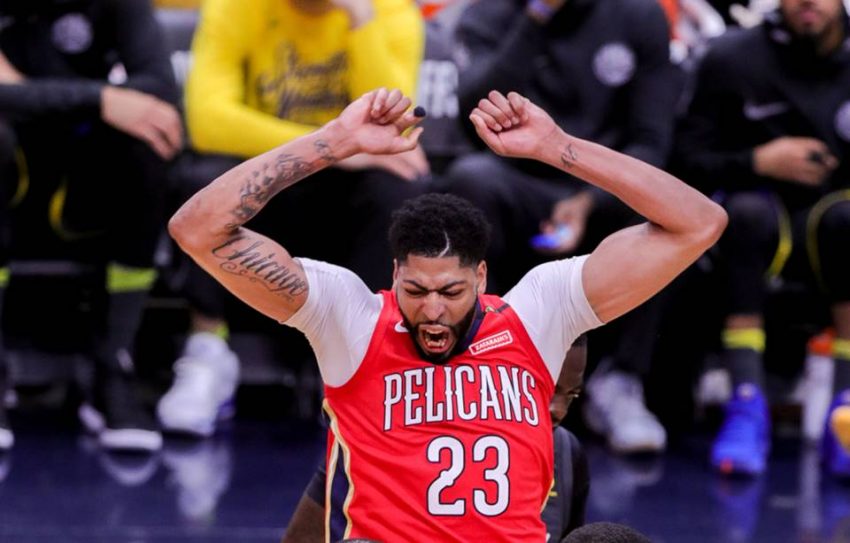The best is yet to come for Anthony Davis

Anthony Davis didn’t take home the Most Valuable Player trophy from Monday night’s 2018 NBA Awards show. He also missed out on Defensive Player of the Year honors.
In a year of incredible individual efforts, the one that AD gave for New Orleans Pelicans was no less impressive or worthy than any of the night’s major award winners.
Davis finished the 2017-18 season with averages of 28.1 points, 11.1 rebounds, a league-leading 2.6 blocks, and 1.5 steals per game.
It should only be a matter of time before an MVP or two is sitting atop his mantle or in his trophy case.
According to basketball-reference.com, Davis is the only player in league history to produce that stat line (remembering of course that blocks didn’t become an official stat until the 1974-74 season).
In fact, since 1973-74 only five players have produced a total of 14 seasons where they averaged at least 25 points, 11 boards, two blocks, and one steal:
- Kareem Abdul-Jabbar (5x)
- Bob McAdoo (3x)
- Anthony Davis, Hakeem Olajuwon, David Robinson (2x)
Davis tied or set career-highs in more than a dozen statistical categories while leading the Pelicans to their best regular season in a decade and to the second round of the playoffs for only the second time in franchise history.
The scary thing is, Anthony Davis is still only 24 years old and still has room for improvement.
Remember that elite five-man club that I mentioned earlier? Of those 14 seasons, nine of them were posted by players aged 25 and older and five of those came after the player’s 29th birthday.
| Player | Age | PTS | REB | BLK | STL |
| Anthony Davis | 24 | 28.1 | 11.1 | 2.6 | 1.5 |
| Anthony Davis | 23 | 28.0 | 11.8 | 2.2 | 1.3 |
| David Robinson | 30 | 25.0 | 12.2 | 3.3 | 1.4 |
| Hakeem Olajuwon | 31 | 27.3 | 11.9 | 3.7 | 1.6 |
| Hakeem Olajuwon | 30 | 26.1 | 13.0 | 4.2 | 1.8 |
| David Robinson | 25 | 25.6 | 13.0 | 3.9 | 1.5 |
| Kareem Abdul-Jabbar | 30 | 25.8 | 12.9 | 3.0 | 1.7 |
| Kareem Abdul-Jabbar | 29 | 26.2 | 13.3 | 3.2 | 1.2 |
| Kareem Abdul-Jabbar | 28 | 27.7 | 16.9 | 4.1 | 1.5 |
| Bob McAdoo | 24 | 31.1 | 12.4 | 2.1 | 1.2 |
| Kareem Abdul-Jabbar | 27 | 30.0 | 14.0 | 3.3 | 1.0 |
| Bob McAdoo | 23 | 34.5 | 14.1 | 2.1 | 1.4 |
| Kareem Abdul-Jabbar | 26 | 27.0 | 14.5 | 3.5 | 1.1 |
| Bob McAdoo | 22 | 30.6 | 15.1 | 3.3 | 1.2 |
(Just a quick aside, Bob McAdoo was awesome. Seriously.)
So how does AD possibly get better?
OFFENSE

Davis shot 53.4 percent from the floor this past season, just one-tenth of a point off of his career best.
Of his 1,462 shot attempts, Anthony Davis took almost 900 jumpers, making just under 39 percent.
What’s encouraging is that AD took more than 100 fewer jump shots than the year before, and increased his dunk and layup attempts by a combined 270 shots. His 245 dunks alone last season topped his previous best by 85.
With Rajon Rondo, DeMarcus Cousins, and Jrue Holiday moving the ball, and the Pelicans playing at Alvin Gentry’s preferred pace for an entire season, his assisted scores rose from 66 percent to almost 72 percent.
Quick translation: Anthony Davis is getting and taking better shots. Part of that is his decision-making, as he settled for fewer mid-range attempts, instead choosing to attack the rim.
He still lacks a consistent go-to move in the low post and a counter move. Davis is hesitant to use the jump hook, still preferring to face up and try to take his man off the dribble or shoot the jumper.
As incredibly efficient as Davis has been throughout his career, imagine him even more so. AD has been a front court player for roughly eight years, after famously growing up handling the ball as a guard.
The subtleties of post play weren’t part of his internship at Kentucky, and he hasn’t had the teammates or systems in place for the majority of his career to make things easier for him. Still, he has career player efficiency rating of 27.1. The 28.9 PER he posted last season was the second highest of his career (30.8 in 2014-15), and after his 25.0 PER in 2015-16, Davis’ numbers have been steadily rising once again.
Another indicator of Davis’ growth potential are his offensive rebounding numbers. Over his first three seasons, AD averaged better than 2.7 offensive boards per game. But, from 2015-17, that number dipped to 2.2 as Davis took more and more jump shots, pushing him farther and farther away from the basket and the glass.
Alvin Gentry’s strategy has been to sacrifice a few offensive rebounds to improve the Pels’ transition defense, but Davis began to return to form last season, grabbing 2.5 caroms off of his own backboard each night.
One player that can reasonably be compared to Anthony Davis in skill set and body type would be Kevin Garnett.
“The Big Ticket” averaged at least three offensive rebounds per game five times in his first ten seasons; four of those consecutively in years seven through 10. Davis enters his seventh season this fall.
An increase of one-half rebound per game would give AD 225 offensive boards over the course of a 75-game season. In his career, Davis has topped the 200 mark just once, during his second year.
Those extra possessions translate into more layups, dunks, and free throws for Davis. Considering Davis shot a career-high 82 percent at the line last season, a scoring title isn’t out of the question.
Davis is still learning his way as a passer as well. His 2.3 assists per game this past season were another career-high, but he turned it over more than twice each game. In six seasons, he’s averaged more assists than turnovers only twice.
DEFENSE

Anthony Davis is one of the most versatile defensive players in the NBA, capable of guarding players in space, on the block, and more than capable at protecting the rim.
So let’s go back to the chart above. In only four of those historic seasons did the player average less than three blocks per game. Davis has two of those four.
In the last decade, only Serge Ibaka (2x) and Hassan Whiteside have topped that mark for an entire season. But, Davis has been right there on a couple of occasions, averaging 2.8 in 2013-14 and 2.9 in 2014-15.
If Davis commits to playing center and the Pelicans can put the type of defenders around AD that funnel players towards the big man, there’s no reason that Davis can’t be an even better shot blocker.
And with the pace of play across the league showing no signs of slowing, Anthony Davis should continue to rack up steals. Davis is able to strip his man as well as jump passing lanes with his incredible athleticism.
The Pelicans’ approach has been to use Davis as defensive deodorant, covering for any mistakes that his teammates may make.
The list of DPOY award winners is filled with anchors; players who aren’t just the best defensive players on their teams, they are the orchestrators of their teams’ defensive efforts.
Anthony Davis has the instincts and the tenacity to take on that role. It’s time for the Pelicans to give it to him.
Rebounding is just as big a factor for Davis on the defensive end. As he’s matured physically, he’s become more tenacious on the glass.
His rebounding average rose from 8.2 as a rookie to 11.8 in 2016-17. Last season his numbers dipped slightly to 11.1, but that was due in large part to the presence of Cousins, a rather prodigious rebounder himself. AD grabbed 11.9 boards a night in the 33 games after Boogie’s injury.
Davis moving above 12 rebounds per game seems like an inevitability rather than a projection.
SUMMARY
One basket. One rebound. Half of a block.
If Anthony Davis can add that to his averages next season, he would become just the second player in NBA history to put up a 30-12-3 season (after the aforementioned McAdoo).
If the Pelicans can provide the type of team success that matches a statistical output like that, #AD4MVP goes from campaign to near certainty.
And he’d still only be 25 years old.
Imagine that.
- < PREV I-Cubs hand 'Cakes fourth straight loss
- NEXT > Riverside football coach Kevin Dizer to speak Wednesday at Life Resources Bottom Line Luncheon
David Grubb
Sports 1280am host/CCS reporter
David Grubb has more than a decade of experience in the sports industry. He began his career with KLAX-TV in Alexandria, La. and followed that up with a stint as an reporter and anchor with WGGB-TV in Springfield, Mass. After spending a few years away from the industry, David worked as sports information director for Southern University at New Orleans…





